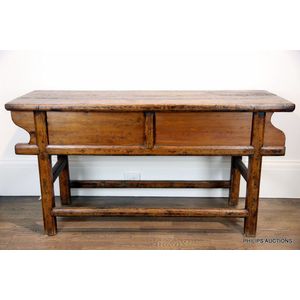Qing Dynasty Altar Table with Interior Cupboards
You must be a subscriber, and be logged in to view price and dealer details.
Subscribe Now to view actual auction price for this item
When you subscribe, you have the option of setting the currency in which to display prices to $Au, $US, $NZ or Stg.
- Rustic - Rustic is defined as "of, relating to, or typical of country life or country people", and the items illustrated in this price guide accord with that definition.
But in the 18th and 19th century "rustic furniture" had a narrower definition. It referred to furniture where the framework was carved or moulded to resemble tree trunks and branches, and was usually for outdoor use. Rustic furniture was made in cast iron, wood, terracootta and concrete. Much of the Coalbrookdale company's cast iron furniture was of rustic design. - Qing Dynasty - The Qing Dynasty was the last imperial dynasty of China, ruling from 1644 to 1912. It was established by the Manchu people, who originated from the northeastern region of China. The Qing Dynasty was preceded by the Ming Dynasty and followed by the Republic of China.
- Ming Dynasty - The Ming Dynasty was a ruling dynasty of China from 1368 to 1644. It succeeded the Yuan Dynasty and preceded the Qing Dynasty. The Ming Dynasty was established by Zhu Yuanzhang, a former Buddhist monk who became a rebel leader and eventually overthrew the Mongol Yuan Dynasty. During the Ming Dynasty, China experienced a period of relative stability and prosperity. The government was centralized and bureaucratic, with the emperor at the top of the hierarchy. The Ming Dynasty is known for its cultural achievements, including the development of porcelain, the invention of movable type printing, and the construction of the Great Wall of China.
This item has been included into following indexes:
- Chinese furniture, chairs - chairs, Qing dynasty 347
- Chinese furniture, tables
- furniture, period or style - oriental 1,735
Visually similar items

A diamond flower ring, comprising a central cluster of six brilliant cut diamonds, claw set. Five pave`set style petals set with single and brilliant cut diamonds. Total diamond weight: 0.95cts. 18 carat white gold. Ring size L.

Continental silver flask, with small cup to interior, tested as silver

Antique 14ct gold mesh fob chain with gold seal. total weight 20.3gm

Set of eight Harlequin coloured Grand Prix chairs by Arne Jacobsen for Fritz Hansen made in 2012
